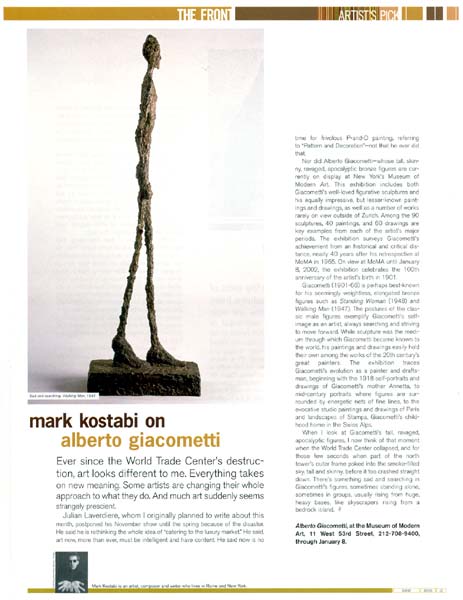Mark Kostabi on Alberto Giacometti

Every since the World Trade Center’s destruction, art looks different to me. Everything takes on new meaning. Some artists are changing their whole approach to what they do. And much art suddenly seems strangely prescient.
Julian Laverdiere, whom I originally planned to write about this month, postponed his November show until the spring because of the disaster. He said he is rethinking the whole idea of “catering to the luxury market.” He said, art now, more than ever, must be intelligent and have content. He said now is no time for frivolous P-and-D painting, referring to “Pattern and Decoration”-not that he ever did that.
Nor did Ablerto Giacometti-whose tall, skinny, ravaged, apocalyptic bronze figures are currently on display at New York’s Museum of Modern Art. This exhibition includes both Giacometti’s well-loved figurative sculptures and his equally impressive, but lesser-known paintings and drawings, as well as a number of works rarely on view outside of Zurich. Among the 90 sculptures, 40 paintings, and 60 drawings are key examples from each of the artist’s major periods. The exhibition surveys Giacometti’s achievement from an historical and critical distance, nearly 40 years after his retrospective at MoMA in 1965. On view at MoMA until January 8, 2002, the exhibition celebrates the 100th anniversary of the artist’s birth in 1901.
Giacometti, (1901-66) is perhaps best-known for his seemingly weightless, elongated bronze figures such as Standing Woman (1948) and Walking Man (1947). The postures of the classic male figures exemplify Giacometti’s self-image as an artist, always searching and striving to move forward. While sculpture was the medium through which Giacometti became known to the world, his paintings and drawings easily hold their own among the works of the 20thh century’s great painters. The exhibition traces Giacometti’s evolution as a painter and draftsman, beginning with the 1918 self-portraits and drawings of Giacometti’s mother Annetta, to mid-century portraits where figures are surrounded by energetic nets of fine lines, to the evocative studio paintings and drawings of Paris and landscapes of Stampa, Giacometti’s childhood home in the Swiss Alps.
When I look at Giacometti’s tall, ravaged, apocalyptic figures, I now think of that moment when the World Trade Center collapsed, and for those few seconds when part of the north tower’s outer frame poked into the smoke -filled sky, tall and skinny, before it too crashed straight down. There’s something sad and searching in Giacometti’s figures, sometimes standing alone, sometimes in groups, usually rising from huge, heavy bases, like skyscrapers rising from a bedrock island.
November 2001